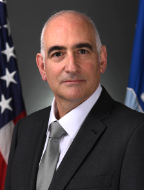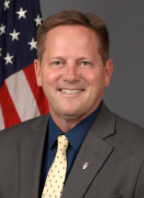Current Space Acquisition Priorities Outlined By USAF Officials
According to Brigadier General Steven P. Whitney, the U.S. Air Force (USAF) is the only department within the entire federal government that has more than one acquisition executive.

This fact is attributed to FY2021’s National Defense Authorization Act (NDAA) that created the second acquisitionnposition for the USAF.

Brig. Gen. Steven
Whitney
Gen. Whitney, who serves as Military Deputy in the Office of the Assistant Secretary of the Air Force for Space Acquisition and Integration, believes that this additional second appointment highlights the importance the federal government is placing on “the space problem,” with acquisition being the clear pathway to the U.S. gaining a strategic edge over near-peer, space race competitors.

Frank Calvelli
During a session on “Accelerating Space Acquisition” during the recent Air Force Association’s (AFA) Air, Space, and Cyber Conference, Frank Calvelli, Assistant Secretary of the Air Force for Space Acquisition and Integration (ASAF/SQ), Dr. Kelly Hammett, Director of the Space Rapid Capabilities Office, and Brig. Gen. Stephen J. Purdy, Program Executive Officer (PEO) of Assured Access to Space, joined Gen. Whitney to examine the current status of space acquisition within the U.S. Department of Defense (DoD), to outline their space acquisition priorities as such pertains to each of their stations, as well as to discuss how commercial industry can assist in propelling the U.S. ahead of its adversaries in the space domain.
Is Speed King?
There is no doubt that Calvelli has a solid and clear vision for space acquisition within the USAF — his three main priorities for the department’s space acquisition initiatives are speed, resiliency, and integration.
During the AFA session, Calvelli explained, “Speed in our acquisitions enables us to deliver new capabilities to our warfighters faster. Resiliency in our space architecture makes sure that space can be counted on during times of crisis and conflict. And integrating space with other warfighting domains supports our operational imperatives in the Department to give our warfighters a strategic edge.”
To achieve speed, Calvelli explained that the Department should start by focusing on building smaller spacecrafts, rather than giant assets that can take many years to produce.
“Building smaller spacecraft can be done faster. It’s just a matter of physics. Going smaller and more manageable…are key enablers to speed,” he said.
He also suggested looking into cutting down on one-time, engineering costs by using existing technology and designs.
“If we build smaller, reduce non-recurring engineering, and execute our plans [on schedule], there’s nothing that can stop us,” Calvelli said.

Dr. Kelly Hammett
For Dr. Hammett, his acquisition priorities are on focus and alignment. Building off Calvelli’s comments on speed, he took it a step further by saying, “Speed is not King… Velocity is King, because velocity is speed with direction.”
According to Dr. Hammett, having a competent workforce that is focused on the same purpose and mission will also accelerate space acquisition.
“If we’re all pulling in the same direction with the same unity of effort and purpose, we can go fast,” he said.
For Gen. Whitney, his priority is delivering on capabilities, while simultaneously building relationships with other organizations.
“You’ve heard a lot of talk…about how we play together with different entities, how the space side plays with the air side, and how we work together in different programs,” said Gen. Whitney. “We’ve got to get those right, and we’ve got to be able to work together.”
Commercial Space + The Adversary
A common theme that was echoed throughout the AFA conference is the growing threat China poses in the space domain.
For Calvelli, the commercial space industry is a resource that the DoD must leverage to counteract our adversaries’ advancements, but delivery schedules need to be drastically reduced from the traditionally drawn out, multi-year contracts.
“We really, truly have a threat from China,” explained Calvelli. “If we really want to go fast, we have got to stop the traditional way of doing satellites with these large, seven-year plus contracts and go to smaller, more proliferated systems, whether they be at MEO, LEO, or even at GEO.”

He added, “So my message to industry is please bid on programs with realistic cost and realistic schedules. And please bid on programs that you can be successful with. And then when you win that contract, execute, and deliver those programs on-cost and on-schedule. That is going to be key to all of our success as a nation and to counter the threat against China.”
For Gen. Purdy, before the commercial space industry can assist the fight against U.S. adversaries, it must first fully understand the DoD’s needs and work towards developing capabilities and solutions that are mission-specific.
“What I really need is for industry to understand where our systems are, what our needs are, and how you can plug into those needs in a non-proprietary way so that we can continue to move along [without] having to go buy licenses from here to eternity,” he said.
Gen. Whitney echoed Gen. Purdy by addressing the commercial space industry directly. He said, “Industry, we need you to deliver on your commitments. Nothing will set us up for success more than you delivering on your commitments.”

Looking to 2023
Before addressing what is coming down the space acquisition pipeline in 2023, Calvelli wanted to first acknowledge and express that he is happily surprised by the pivot and the architecture changes that the U.S. Space Force has already started.
“They have done an absolute magnificent job of getting to more of a hybrid architecture that includes more proliferated systems, more smaller systems, some larger systems, and a much more resilient architecture,” said Calvelli.
“For me, the focus of next year is executing and actually making sure that we deliver on the great set of work that’s been done in the past couple of years by the Department and by the Space Force…Execution is really a key thing for us this next year,” he noted.
To learn more about Frank Calvelli’s space acquisition priorities and the role the commercial space industry will play in delivering upon his priorities, select this direct link...

David Pesgraves
This article first appeared first on GovSat and is republished with permission of GSR and SES-GS.
ses-gs.com/govsat
Author David Presgraves is a Staff Writer for GovSat Report, in addition to several other online several other online publications dedicated to defense, military, and federal government agency technologies.

